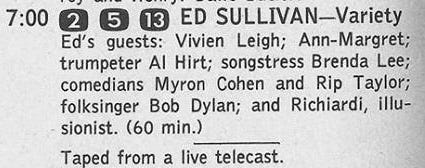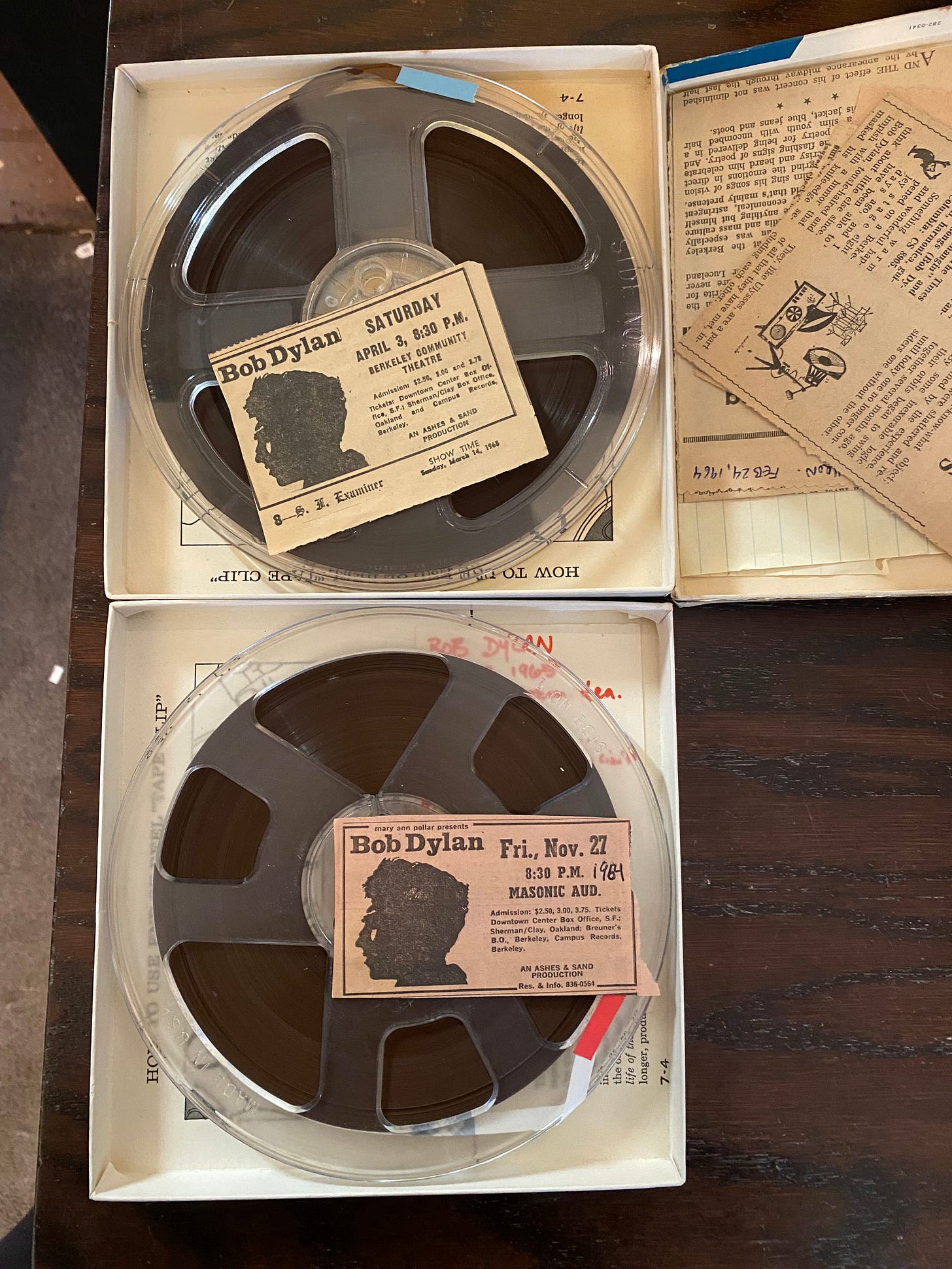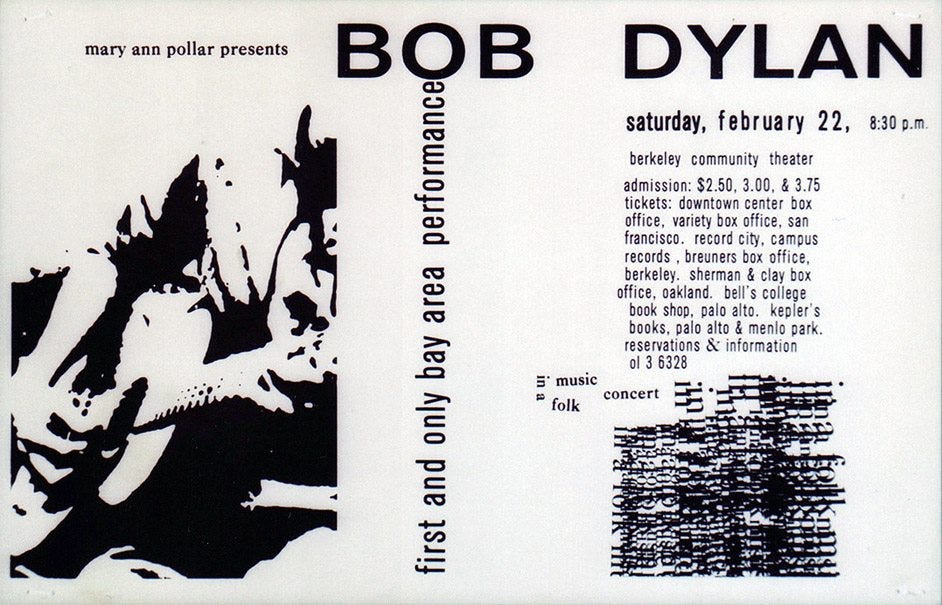Never-Heard '60s Dylan Tape #1: Berkeley 1964
February 22, 1964 - Berkeley Community Theatre, Berkeley, CA
A few days ago, I shared the story behind four never-circulated tapes from Bob Dylan’s Bay Area concerts in 1964 and 1965. As I detailed in that post, they were recorded by a counterculture figurehead named Ray Andersen and recently acquired by the Bob Dylan Archives in Tulsa. There are currently no plans to release them, but researchers can listen to them at the Archives, which is what I did this summer.
To recap, there are four newly-acquired tapes:
February 22, 1964 - Berkeley Community Theatre, Berkeley, CA
November 27, 1964 - Masonic Memorial Auditorium, San Francisco, CA
April 3, 1965 - Berkeley Community Theatre, Berkeley, CA
December 11, 1965, Masonic Memorial Auditorium, San Francisco, CA
Today, I begin to go into more detail about the tapes themselves, show by show. What’s on them, what have we heard before in other forms, what haven’t we ever heard, and, most importantly of course, are they good?
Or maybe I should say: How good are they? I mean, it’s Bob Dylan in the mid-’60s—of course they’re good! First up:
February 22, 1964 - Berkeley Community Theatre, Berkeley, CA
In his Bob Dylan Day-By-Day book, Clinton Heylin calls this “one of his most legendary performances.” But the legend, such as it is, comes solely from reports from those who were there. No tape has ever been heard until now.
This was Dylan’s first-ever show in the Bay Area, coming at the end of a cross-country road trip he took with Paul Clayton, Victor Maymudes, and Pete Karmen that included stops to support striking miners, visit Carl Sandburg, and perform a few shows. Dylan’s contemporary Richard Fariña, in a review that ran in Mademoiselle magazine, set the scene for this college concert:
When Bob Dylan drove across the Berkeley campus with his songs in a hip pocket and a station wagon full of friends, it was as if the undergraduates had been whispering of his imminent arrival for months. They seemed, occasionally, to believe he might not actually come, that some malevolent force or organization would get in the way. From north into Oregon and as far south as Fort Ord, near Monterey, college-age listeners had found time to make the trip, secure tickets, and locate seats in the mammoth Berkeley Community Theatre. They had come with a sense of collective expectancy, some attracted by already implausible legends, some critical of an idiom that seemed too maverick to be substantial, but most with an eye to taking part in a passing event that promised more than usual significance for their generation.
Reviews were rapturous. Ralph Gleason in the San Francisco Chronicle wrote, “Genius makes its own rules and Dylan is a genius, a singing conscience and moral referee as well as a preacher.” These reviews are the source of the legend around this show.
I’ll say it up front: This is my favorite tape of the four. Sony should find a way to release it as a live album immediately. It showcases Dylan at his most charming and winning, at the start of the final year before he’d start getting restless to try on a new sound. In fact, this marks the only existing concert tape from the first four months of 1964. Prior to this, the earliest 1964 tape came from May 17 at London’s Royal Festival Hall, which I wrote about here.
What makes this tape so special? A few things, but I’ll start with the big one: BobTalk. He is as chatty as I’ve ever heard him, talking at length in between practically every song. There are jokes, yarns, and even explanations of what some songs mean. For instance, here’s what he tells the crowd before “Who Killed Davey Moore?”:
I wrote a song about two years ago in the springtime called “Blowin in the Wind.” I had nine questions… I abandoned the song a year ago and I wrote nine songs out of it instead. And this is one of the nine songs. This is called “Who Killed Davey Moore” Davey Moore was a boxer that got killed in the boxing ring. Just doing his job. [audience laughs] This is a true story, only the words have been changed.
“Audience laughs” is a phrase I wrote down a lot in my notes. The show sounds like a standup routine at times. The crowd laughs at his jokes between songs, and also about funny lyrics in the songs themselves, many of which they likely hadn’t heard before. I’ve recently listened to a bunch of 1961 and 1962 concerts. He’s funny there too, but in an aw-shucks neophyte sort of way, making endearing all his fumbling around with faulty harmonica racks and his out-of-tune guitars. By February 1964, he has the audience in the palm of his hand—and he knows it.
Another difference from those early-’60s shows: This audience knows him, and they know the lore. Before “Talkin’ John Birch Paranoid Blues,” he tells the story of getting kicked off the Ed Sullivan Show in May 1963. From the audience response, you can tell this information isn’t news to them. But the way he explains it is quite amusing:
Here’s a song I was gonna sing on the Ed Sullivan show. [audience laughs, cheers] Really, it’s a terrible song. The only reason I’m gonna sing it is because I’m not allowed to sing it there. I passed all the examinations on the show, and I did take my tryout, and they were gonna put it through, all til the last minute. The censor said “You can’t sing that. You have to sing something nice.” I said, [sighs] “Whaddya mean?” He said, “Well, we’ve had folksingers on here before. And they all sang something nice. Don’t you know anything nice? Like the Clancy Brothers.” And he said some other ones too. I said, “No.” Brenda Lee dug it though.
The line “Really, it’s a terrible song” cracks me up. Although I disagree; it’s a great song, albeit one written in a framework, the talking blues, he was moving beyond by this point. I hadn’t realized Brenda Lee was on the same show either.

Dylan here knows when to bring the mood down too. No laughs for the dark “North Country Blues” (“This is about iron ore mining. I wrote this song in [hard to make out, sounds like Williamsburg?].”) His singing on “Restless Farewell” is quiet and tender, full of emotion, the audience hanging on every word. Or when to get sincere, as on a beautifully fingerpicked “Girl from the North Country”—with some unusually funky harmonica flourishes—or his duets with Joan Baez. When he introduces her, he says “I wouldn’t be here tonight if it wasn’t for some people. One of those people is here. I want to bring her out here. Eek! [laughs] Joan Baez.”
That’s right: Joan Baez is here. Eek! She was not advertised in advance, so her appearance must have been an exciting surprise to the crowd. Gleason’s review praised “their series of deeply moving duets in which the crystal purity of her voice strangely complemented the rough tones of Dylan.” He was dead on.
Most excitingly to us tape nerds who think we’ve heard it all, there’s a never-heard duet on this tape. When I wrote my big tribute to Bob and Joan’s duets, I noted in the intro a few songs they reportedly dueted on at some point that have never been heard. Well now one of them has: “Farewell”! It’s gorgeous. Baez hums behind Dylan on the verses, then joins him for the chorus. It instantly ranks near the top of my favorite of their '60s duets.
They duet on three other songs too here: “With God on Our Side,” “Blowin’ in the Wind,” and “When the Ship Comes In.” The latter is most notable as it is the only time we can hear a proper concert performance of it. Up until now, the only recording of this duet came from the March on Washington. The format here is the same—mostly background ooh’ing and aah’ing from Baez, until she sings along on the final climactic verses—but the sound quality is better.
Bob even works Joan into one of his standup routines. When introducing “With God on Our Side,” he goes on a long yarn about the recently-released movie Hootenanny Hoot. It’s clearly one of his standard “bits”; you can hear a different version on the Carnegie Hall 1963 show four months earlier. But this one starts with a joke (or is it a jab?) about Joan:
I have to tell you about this folksinging business. I don’t know anybody that [mumbles]. So this is a folksinger. [big applause, I assume he’s indicating Joan] I was just kidding ya. Anyway, it got a little bit confused. There’s a lot of confusion in here about what it is and what it isn’t. It doesn’t really make any difference. But there’s one part of it that says it’s one thing.
I saw a movie. It’s called Hootenanny Hoot. One second I was tired and I was walking up 42nd Street and I was there. I saw the movie, and the story of the movie is the story of folk music. How it happened.
The way it happened was there was a television director in New York City [huge audience laughs] and he was driving out to the West Coast and he came upon a hootenanny in the middle of Kansas. Bathing beauties and the Pacific Ocean. [audience laughs] He wired back to a director in New York City saying, “I’ve got the new thing. It’s hootenanny.” And the director says, “Well how good is it? Will it sell soap?” He said, “Well I don’t know if it’s that good.” “Well maybe I’ll come out and see.” So the television guy went out to Kansas and sure enough, he saw a folk singer, it was a girl singing folk songs. She was singing about the death of somebody on top of [?] bathing suits. All across the park benches. With again the Pacific Ocean, and Hawaii off in the distance. And this was in Kansas. He said, “By god, that is good enough to sell soap. Let’s bring it back to New York and start it out.”
And that’s what happened. That’s the story of folk music. [inaudible] There are a lot of people who come under the category of folk singers that don’t wanna sell soap. [inaudible] [big audience laugh/cheer]
Here’s the tracklist of the Berkeley 1964 tape. This is almost certainly not the complete show; the newspaper reviews mention a few other songs not included here. But it’s more than enough. Amazing that historic tapes like this are still surfacing sixty years later.
Who Killed Davey Moore?
Talkin’ John Birch Paranoid Blues
The Times They Are A-Changin’
Girl From The North Country
North Country Blues
Restless Farewell
Farewell
When the Ship Comes In
With God on Our Side
Blowin’ In The Wind
(Side note: It’s funny how he seemingly grouped his two “North Country” and his two “Farewell” songs together.)



Where's the "Release This Now" petition? I want to sign! Fantastic write up.
>>Amazing that historic tapes like this are still surfacing sixty years later.<<
Wonders never cease. . .
Great review!